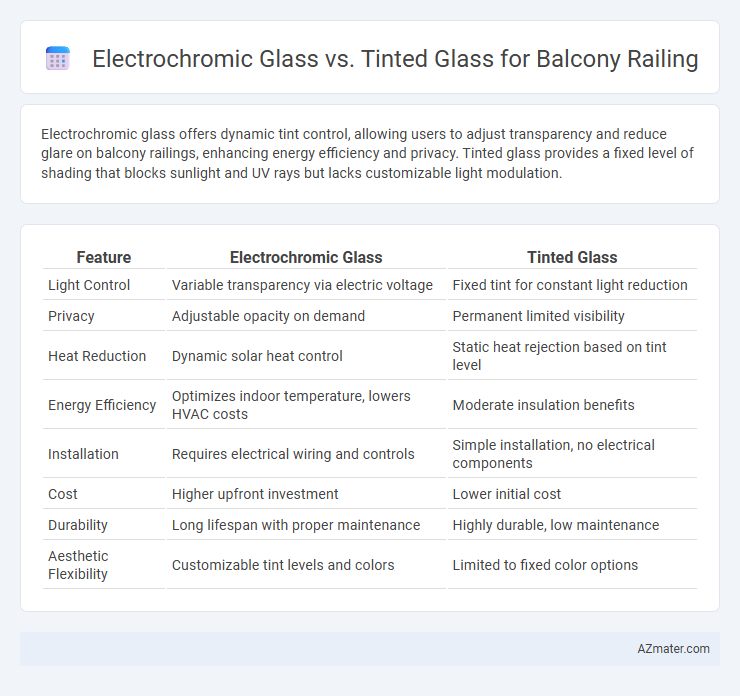Electrochromic glass offers dynamic tint control, allowing users to adjust transparency and reduce glare on balcony railings, enhancing energy efficiency and privacy. Tinted glass provides a fixed level of shading that blocks sunlight and UV rays but lacks customizable light modulation.
Table of Comparison
| Feature | Electrochromic Glass | Tinted Glass |
|---|---|---|
| Light Control | Variable transparency via electric voltage | Fixed tint for constant light reduction |
| Privacy | Adjustable opacity on demand | Permanent limited visibility |
| Heat Reduction | Dynamic solar heat control | Static heat rejection based on tint level |
| Energy Efficiency | Optimizes indoor temperature, lowers HVAC costs | Moderate insulation benefits |
| Installation | Requires electrical wiring and controls | Simple installation, no electrical components |
| Cost | Higher upfront investment | Lower initial cost |
| Durability | Long lifespan with proper maintenance | Highly durable, low maintenance |
| Aesthetic Flexibility | Customizable tint levels and colors | Limited to fixed color options |
Introduction to Balcony Railing Glass Options
Electrochromic glass offers dynamic light control through electronically adjustable tinting, enhancing privacy and energy efficiency for balcony railings. Tinted glass provides a fixed color shade that reduces glare and UV exposure but lacks the adaptability of electrochromic technology. Choosing between these options depends on priorities like flexibility, aesthetics, and environmental responsiveness for balcony railing applications.
What Is Electrochromic Glass?
Electrochromic glass, also known as smart glass, dynamically changes its tint in response to an electrical voltage, offering customizable light and heat control for balcony railings. Unlike traditional tinted glass, which has a fixed color and reduces glare and UV exposure passively, electrochromic glass actively adjusts transparency to optimize privacy, energy efficiency, and comfort. This adaptive technology enhances outdoor living spaces by seamlessly balancing natural light management and aesthetic appeal.
Understanding Tinted Glass
Tinted glass for balcony railing offers a cost-effective solution by reducing glare and heat through a uniform colorant embedded in the glass, enhancing privacy and energy efficiency. Unlike electrochromic glass, which dynamically adjusts transparency via electronic controls, tinted glass maintains a fixed shade that limits visible light transmission and ultraviolet rays. Understanding tinted glass involves recognizing its benefits in passive solar control and aesthetic customization without the complexity of electronic components or power requirements.
Performance in Sunlight: Electrochromic vs Tinted
Electrochromic glass adjusts its tint dynamically in response to sunlight intensity, providing superior glare control and thermal regulation compared to static tinted glass. Tinted glass reduces solar heat gain uniformly but may darken views and lacks the adaptability of electrochromic technology under varying light conditions. Electrochromic glass enhances energy efficiency by modulating visible light and solar heat transmission, optimizing comfort on balcony railings throughout the day.
Energy Efficiency Comparison
Electrochromic glass for balcony railings offers dynamic control over solar heat gain and natural light, significantly reducing cooling loads and enhancing energy efficiency compared to static tinted glass. Unlike tinted glass, which provides fixed shading that can lead to excessive heat retention or inadequate daylight, electrochromic glass adjusts its tint in response to sunlight, optimizing indoor temperatures. Studies show that buildings with electrochromic glazing can reduce HVAC energy consumption by up to 20%, outperforming traditional tinted glass solutions in energy savings and occupant comfort.
Privacy Control and Customization
Electrochromic glass offers dynamic privacy control by enabling users to switch transparency levels on demand, providing customizable shading for balcony railings. Tinted glass provides a fixed level of opacity or color, limiting customization but effectively reducing glare and visibility. The advanced control capabilities of electrochromic glass make it superior for tailored privacy needs compared to the static nature of tinted glass.
Aesthetics and Design Flexibility
Electrochromic glass offers dynamic opacity control, allowing balcony railings to shift from transparent to opaque, providing customizable aesthetics and enhanced privacy. Tinted glass has a fixed color or shade that reduces glare and UV exposure but lacks adjustability, limiting design flexibility. The ability of electrochromic glass to adapt to changing lighting and privacy needs makes it a superior choice for modern, versatile balcony railing designs.
Installation and Maintenance Considerations
Electrochromic glass installation for balcony railings requires specialized electrical wiring and control systems, leading to higher initial setup complexity compared to the straightforward mounting of tinted glass. Maintenance of electrochromic glass involves periodic checks of electronic components and software updates, whereas tinted glass primarily demands routine cleaning and inspection for physical damage. The advanced functionality of electrochromic glass offers dynamic light control but necessitates professional servicing, while tinted glass provides a low-maintenance, passive solution.
Cost Analysis: Upfront and Long-Term
Electrochromic glass for balcony railings typically involves a higher upfront cost due to advanced technology and installation complexity, often ranging from $100 to $150 per square foot compared to tinted glass, which averages $25 to $50 per square foot. Long-term expenses favor electrochromic glass given its energy-saving properties, reducing cooling costs by up to 20%, whereas tinted glass offers moderate heat reduction but lacks dynamic control. Maintenance and durability of electrochromic glass can be more cost-intensive, while tinted glass requires minimal upkeep, making the initial investment a critical factor in cost-benefit analysis.
Which Glass Is Best for Your Balcony Railing?
Electrochromic glass offers dynamic tinting that adjusts to sunlight intensity, providing enhanced privacy, energy efficiency, and glare control for balcony railings. In contrast, tinted glass has a fixed shade that reduces UV exposure and heat but lacks adaptability to changing light conditions. Choosing between them depends on your priority for customization versus cost, with electrochromic glass excelling in smart functionality and tinted glass serving as an affordable, low-maintenance option.

Infographic: Electrochromic glass vs Tinted glass for Balcony railing
 azmater.com
azmater.com